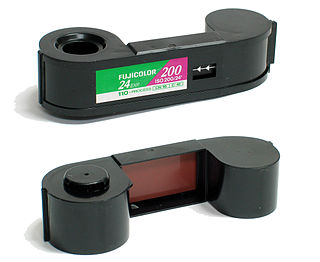This page is based on this
Wikipedia article Text is available under the
CC BY-SA 4.0 license; additional terms may apply.
Images, videos and audio are available under their respective licenses.

Film stock is an analog medium that is used for recording motion pictures or animation. It is a strip or sheet of transparent plastic film base coated on one side with a gelatin emulsion containing microscopically small light-sensitive silver halide crystals. The sizes and other characteristics of the crystals determine the sensitivity, contrast and resolution of the film. The emulsion will gradually darken if left exposed to light, but the process is too slow and incomplete to be of any practical use. Instead, a very short exposure to the image formed by a camera lens is used to produce only a very slight chemical change, proportional to the amount of light absorbed by each crystal. This creates an invisible latent image in the emulsion, which can be chemically developed into a visible photograph. In addition to visible light, all films are sensitive to X-rays and high-energy particles. Most are at least slightly sensitive to invisible ultraviolet (UV) light. Some special-purpose films are sensitive into the infrared (IR) region of the spectrum.

The Eastman Kodak Company is an American technology company that produces camera-related products with its historic basis on photography. The company is headquartered in Rochester, New York, and is incorporated in New Jersey. Kodak provides packaging, functional printing, graphic communications and professional services for businesses around the world. Its main business segments are Print Systems, Enterprise Inkjet Systems, Micro 3D Printing and Packaging, Software and Solutions, and Consumer and Film. It is best known for photographic film products.
The following list comprises significant milestones in the development of photography technology.

110 is a cartridge-based film format used in still photography. It was introduced by Kodak in 1972. 110 is essentially a miniaturised version of Kodak's earlier 126 film format. Each frame is 13 mm × 17 mm, with one registration hole. There were 24 frames per cartridge that occasionally enabled the user to capture an extra image due to production variations.

Disc film was a still-photography film format aimed at the consumer market, and introduced by Kodak in 1982.

Kodachrome is a brand name for a non-substantive, color reversal film introduced by Eastman Kodak in 1935. It was one of the first successful color materials and was used for both cinematography and still photography. For many years Kodachrome was widely used for professional color photography, especially for images intended for publication in print media. Because of its complex processing requirements, the film was sold process-paid in the United States until 1954 when a legal ruling prohibited this. Elsewhere, this arrangement continued.

In photography, reversal film is a type of photographic film that produces a positive image on a transparent base. The film is processed to produce transparencies or diapositives instead of negatives and prints. Reversal film is produced in various sizes, from 35 mm roll film to 8×10 inch sheet film.

Agfacolor was the name of a series of color film products made by Agfa of Germany. The first Agfacolor, introduced in 1932, was a film-based version of their Agfa-Farbenplatte, a "screen plate" product similar to the French Autochrome. In late 1936 Agfa introduced Agfacolor Neu, a pioneering color film of the general type still in use today. The new Agfacolor was originally a reversal film used for making "slides", home movies and short documentaries. By 1939 it had also been adapted into a negative film and a print film for use by the German motion picture industry. After World War II, the Agfacolor brand was applied to several varieties of color negative film for still photography, in which the negatives were used to make color prints on paper. The reversal film was then marketed as Agfachrome.
Kodachrome was a brand of color transparency film sold by Kodak.
A chromogenic print, also known as a silver halide print, or a dye coupler print, is a photographic print made from a color negative, transparency, or digital image, and developed using a chromogenic process. They are composed of three layers of gelatin, each containing an emulsion of silver halide, which is used as a light-sensitive material, and a different dye coupler of subtractive color which together, when developed, form a full-color image.
Keller-Dorian cinematography was a French technique from the 1920s for filming movies in color, using a lenticular process to separate red, green and blue colors and record them on a single frame of black-and-white film. This additive color system differs from other systems, for example Technicolor, which divided the colors into more than one frame on one or more pieces of film.

Photographic film is a strip or sheet of transparent plastic film base coated on one side with a gelatin emulsion containing microscopically small light-sensitive silver halide crystals. The sizes and other characteristics of the crystals determine the sensitivity, contrast and resolution of the film.
The Kodak Cine Special 16mm Cameras (CKS) are a family of precision, versatile, spring-wound 16mm silent movie cameras produced by Eastman Kodak from the 1930s to the 1960s, and intended for advanced consumers and industry professionals. While its rectangular format was typical of earlier Kodak 16 mm cameras, the CKS 'box' was formed by two joined sections: the spring motor half with the user controls, winding cranks, and gear work to the shutter. The other half was a film magazine which docked to the motor. This allowed the cinematographer to pre-load multiple magazines of film for quick interchange of film.








